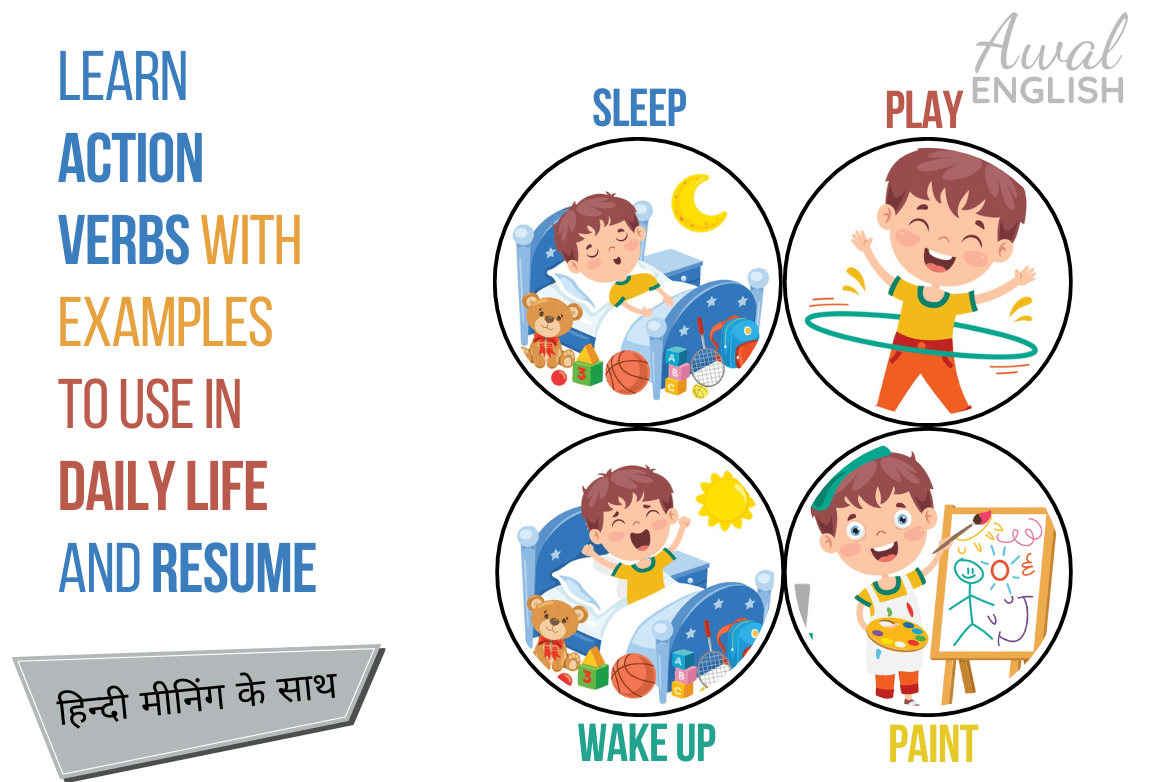
session with mentors
If you’re wondering what action verbs are, don’t worry, we’ve got you covered. Action verbs in English grammar are those exciting words that describe what someone is doing or what’s happening. They add spice to our sentences and make them way more interesting. In this blog, we’re going to explore a lot of action verbs that you can use every day, whether you’re chatting with friends or writing something important, like a resume. We’ll show you examples of how to use them so you can see just how awesome they are. In this blog, we will be covering action verbs list with Hindi meaning to help you clear your basic English and become fluent in speaking English These learn English online and will improve your English fluency.
What Do You Mean By Action Verb?
An action verb in English is a word that shows what someone or something is doing. It’s like a little action-packed superhero in a sentence! Instead of just sitting there, action verbs jump into action and tell us about all the exciting things happening around us. Whether it’s running, jumping, eating, or even thinking, action verbs bring our language to life by describing actions and movements. So, the next time you want to spice up your sentences, remember to call upon these mighty action verbs to add some fun and energy!
Definition of Action Verb
An action verb is a word that describes an action. It tells us what someone or something is doing.
For example, in the sentence “She runs in the park,” the word “runs” is the action verb because it shows the action of running.
Action verb वो शब्द होता है जो किसी action के बारे में बताता है। यह हमें बताता है कि कोई व्यक्ति या चीज़ क्या कर रहा/रही है।
Example के लिए, वाक्य “वह park में दौड़ती है” में, “दौड़ती” शब्द action verb है क्योंकि यह दौड़ने के action को दिखाता है।
Types of Action Verbs
Action verbs, also known as dynamic verbs, express an action or activity that a subject is performing. They are an essential component of sentences as they convey the action or movement within them. Here are two main types of action verbs:
Transitive Verbs: These verbs use a direct object to complete their meaning.
इन verbs को अपना मतलब बताने के लिए direct object की ज़रूरत पड़ती है।
For example: “She ate (transitive verb) the cake (direct object).”
Intransitive Verbs: These verbs do not require a direct object to complete their meaning.
इन verbs को अपना मतलब बताने के लिए direct object की ज़रूरत नहीं पड़ती है।
For example: “He ran (intransitive verb).”
Know How and When To Use an Action Verb
In English grammar, action verbs are used to describe actions or activities performed by a subject. Here’s how and where you can use action verbs:
Subject-Verb Agreement: Action verbs agree with the subject in a sentence.
For example, in the sentence “She walks,” the action verb “walks” agrees with the singular subject “she.”
Predicate of a Sentence: Action verbs often function as the main predicate in a sentence, indicating what the subject is doing.
For instance, in the sentence “The cat jumps,” the action verb “jumps” describes the action of the subject “cat.”
Expressing Tenses: Action verbs are used to indicate the time at which an action occurs, such as present, past, or future tense.
For example, “I walk” (present tense), “I walked” (past tense), and “I will walk” (future tense).
Active Voice: Action verbs are crucial in constructing sentences in the active voice, where the subject acts.
For example, “She teaches English” is in the active voice, with the subject “she” acting as teaching.
Imperatives: Action verbs are used to give commands or instructions in imperative sentences.
For example, “Open the door” uses the action verb “open” to command someone to act as an opening.
Describing Activities: Action verbs are used to describe various activities, movements, or processes.
For example, “They swim in the pool” uses the action verb “swim” to describe the activity of swimming.
यहाँ हमने देखा कि action verb का इस्तेमाल किसी भी sentence में subject और predicate दोनों के साथ किया जाता है, साथ ही action verb को हम active voice, tenses, imperatives या किसी काम के बारे में बताने के लिए कर सकते हैं।
Points to Remember: Do Not Use Action Verbs Here
In English grammar, action verbs are typically used to describe actions or activities performed by a subject. However, there are some cases where action verbs may not be appropriate or necessary:
Linking Verbs:
In sentences where a state of being or a condition is expressed, linking verbs are used instead of action verbs.
For example, in the sentence “She is happy,” the linking verb “is” connects the subject “she” to the adjective “happy” rather than indicating an action.
Passive Voice:
In passive voice constructions, the action is done to the subject rather than performed by the subject. Action verbs are less common in passive voice sentences, where the emphasis is on the recipient of the action rather than the doer.
For example, “Jatin read the book” is in the passive voice, with the action verb “read” being used passively.
Gerunds or Infinitives as Nouns:
Sometimes, action verbs can be transformed into gerunds (verbs ending in -ing used as nouns) or infinitives (to + base form of the verb) to function as nouns in a sentence.
For example, “Reading is my favourite hobby” uses the gerund “reading” as the subject of the sentence.
Intransitive Verbs in Passive Constructions:
Intransitive verbs (verbs that do not require a direct object) typically do not appear in passive constructions.
For example, the intransitive verb “arrive” cannot be used in the passive voice; you cannot say “The train arrived” (passive voice) but rather “The train arrived” (active voice).
Overall, while action verbs are versatile and essential in English grammar, there are specific grammatical structures and contexts where they may not be used or where other verb forms are more appropriate.
English grammar में कई ऐसे नियम है जिनके चलते हम कई जगह पर action verb का इस्तेमाल नहीं कर सकते जैसे linking verb के साथ, passive voice, intransitive verbs, और noun की तरह इस्तेमाल होने वाले gerunds या infinitives के साथ।
Action Verb List to Use in Daily Life With Hindi Meanings and Example
Here you will find action verbs examples that you can use in your daily life conversation and these action verb lists will help you improve your English. Below is an action verbs list with Hindi meanings and examples that you can use in your daily use sentences for conversation and learning English online.
Run (दौड़ना)
Example: She likes to run in the park every evening.
वह हर शाम पार्क में दौड़ना पसंद करती है।
Eat (खाना)
Example: They eat dinner at 8 o’clock.
उन्होंने आठ बजे रात को रात का खाना खाया।
Sleep (सोना)
Example: The baby sleeps for ten hours a day.
बच्चा रोज़ दस घंटे सोता है।
Talk (बात करना)
Example: We talked for hours about our future plans.
हमने घंटों तक हमारे भविष्य के plans के बारे में बात की।
Walk (चलना)
Example: They walk to the market every morning.
वो हर सुबह बाज़ार जाते हैं।
Read (पढ़ना)
Example: He reads novels before going to bed.
वह सोने से पहले कहानियाँ पढ़ता है।
Write (लिखना)
Example: She writes poetry in her free time.
वह अपने खाली समय में कविता लिखती है।
Sing (गाना)
Example: He sings beautifully in the choir.
वह choir में खूबसूरती से गाता है।
Dance (नाचना)
Example: They danced all night at the wedding.
उन्होंने शादी में पूरी रात dance किया।
Laugh (हंसना)
Example: The comedian’s jokes made everyone laugh.
Comedian के jokes ने सबको हंसाया।
Cry (रोना)
Example: She cried when she heard the sad news.
वो दुखद समाचार सुनकर रोने लगी।
Drive (चलाना)
Example: He drives his car to work every day.
वह रोज़ अपनी गाड़ी चलाकर काम पर जाता है।
Cook (पकाना)
Example: She cooks delicious meals for her family.
वह अपने परिवार के लिए स्वादिष्ट खाना पकाती है।
Clean (साफ करना)
Example: They clean their house every weekend.
वे हर हफ्ते अपने घर को साफ़ करते हैं।
Study (पढ़ाई करना)
Example: He studies for his exams every night.
वह हर रात अपनी परीक्षा के लिए पढ़ाई करता है।
Work (काम करना)
Example: They work in the office from 9 to 5.
वे नौ बजे से पाँच बजे तक office में काम करते हैं।
Play (खेलना)
Example: Children love to play in the park.
बच्चे park में खेलने का शौक़ रखते हैं।
Listen (सुनना)
Example: She listens to music while studying.
वह पढ़ाई करते समय संगीत सुनती है।
Watch (देखना)
Example: They watch movies on weekends.
वे weekend पर फ़िल्में देखते हैं।
Shop (खरीददारी करना)
Example: She shops for groceries every Monday.
वह हर सोमवार को किराने के सामन की खरीददारी करती है।
Exercise (कसरत करना)
Example: He exercises at the gym for an hour every day.
वह हर दिन gym में एक घंटा कसरत करता है।
Swim (तैरना)
Example: They swim in the lake during the summer.
वे गर्मियों में झील में तैरते हैं।
Climb (चढ़ना)
Example: He climbs mountains as a hobby.
वह शौक के तौर पर पहाड़ों पर चढ़ता है।
Jump (कूदना)
Example: The athlete jumps over the hurdles effortlessly.
खिलाड़ी बिना किसी परेशानी के hurdles पर कूदता है।
Create (बनाना)
Example: She creates beautiful paintings in her studio.
वह अपने studio में कई खूबसूरत चित्र बनाती है।
Organise (आयोजन करना)
Example: They organise events for charity every year.
वे हर साल charity के लिए कार्यक्रम आयोजित करते हैं।
Plan (योजना बनाना)
Example: We plan to go on a vacation next month.
हम अगले महीने छुट्टी पर जाने की योजना बना रहे हैं।
Teach (सिखाना)
Example: She teaches at a local school.
वह local school में अंग्रेज़ी पढ़ाती है।
Learn (सीखना)
Example: He learns to play the guitar online.
वह online guitar बजाना सीख रहा है।
Relax (आराम करना)
Example: They relax by the beach on weekends.
वे weekends पर beach पर आराम करते हैं।
Stand (खड़ा होना)
Example: He stands in line for tickets.
वह ticket के लिए line में खड़ा है।
Sit (बैठना)
Example: She likes to sit in the garden and read.
वह बगीचे में बैठकर पढ़ने का शौक़ रखती है।
Bend (मोड़ना)
Example: He bends down to tie his shoelaces.
वह अपने जूते को बाँधने के लिए झुका।
Stretch (खींचना)
Example: They stretch their arms before exercising.
वे कसरत से पहले अपने हाथों को खींचते हैं।
Brush (दांत साफ़ करना)
Example: He brushes his teeth before going to bed.
वह सोने से पहले अपने दांत साफ करता है।
Comb (कंघी करना)
Example: She combs her hair before leaving for work.
वह काम पर जाने से पहले अपने बाल कंघी करती है।
Shower (नहाना)
Example: He takes a quick shower after the gym.
वह gym के बाद जल्दी से नहा लेता है।
Bathe (नहाना)
Example: She bathes her baby every evening.
वह हर शाम अपने बच्चे को नहलाती है।
Shave (दाढ़ी बनाना)
Example: He shaves before going to work.
वह काम पर जाने से पहले दाढ़ी बनाता है।
Text (संदेश (message) भेजना)
Example: She texts her friends to meet up for lunch.
उसने दोस्तों को lunch के लिए मिलने के लिए message भेजा।
Email (ईमेल भेजना)
Example: He emails the report to his boss.
उसने अपनी report को अपने boss को email किया।
Call (कॉल करना)
Example: They call their parents every Sunday.
वे हर रविवार अपने माता-पिता को call करते हैं।
Type (keyboard पर कुछ लिखना)
Example: She types quickly on the keyboard.
वह keyboard पर तेज़ी से type करती है।
Scroll (Phone चलाना या phone पर चीज़ें ढूंढना)
Example: He scrolls through social media before bed.
वह सोने से पहले social media scroll करता है।
Post (Social media पर कुछ डालना)
Example: She posts pictures from her vacation on Instagram.
उसने अपनी छुट्टियों की तस्वीरें instagram पर post की।
Share (बांटना)
Example: They share interesting articles with their friends.
उसने अपने दोस्तों के साथ दिलचस्प लेख share किये।
Like (पसंद करना)
Example: He likes all the photos his friends post.
उसने अपने दोस्तों की सभी photos को like किया।
Comment (टिप्पणी करना)
Example: She comments on her friend’s status.
उसने अपने दोस्त के status पर comment किया।
Action Verbs For Resume With Hindi Meaning and Examples
You might be wondering about an action verbs list for your resume, then this blog has got you covered. Here you will find action verbs for your resume, that you can use in your resume to reflect your personality. These action verbs for a resume will help you describe your skills and personality and will also help you become fluent in English.
Lead (नेतृत्व करना)
Example: She leads the team with confidence.
वह team को आत्मविश्वास के साथ lead करती है।
Manage (प्रबंधन करना)
Example: He manages the project efficiently.
उसने project को बेहतरीन तरीके से manage किया।
Develop (तैयार करना या बनाना)
Example: The company develops new software products.
Company ने नए software product को तैयार किया।
Create (कुछ बनाना)
Example: She creates innovative designs for her clients.
उसने अपने ग्राहकों के लिए नई design बनाई।
Implement (लागू करना)
Example: They implement new strategies to improve efficiency.
उन्होंने कुशलता में सुधार के लिए नई रणनीतियों को लागू किया।
Coordinate (कई अलग-अलग चीज़ों का एक साथ अच्छी तरह से काम करना)
Example: He coordinates between different departments.
वह कई विभागों के बीच coordinate करता है।
Analyze (किसी चीज़ को देखना या उसके बारे में गहराई से पढ़ना)
Example: They analyze market trends to make informed decisions.
उन्होंने सही फैसला लेने के लिए बाज़ार के trends को analyze किया।
Strategize (रणनीति बनाना)
Example: The team strategizes for the upcoming project.
Team आगे आने वाले project के लिए रणनीति बना रही है।
Innovate (कुछ नया करना या बनाना)
Example: They innovate new solutions to old problems.
वो पुरानी समस्याओं के लिए नए समाधान ढूंढ रहे हैं।
Collaborate (सहयोग करना)
Example: She collaborates with other departments on projects.
उसने projects पर बाकी विभागों के साथ सहयोग किया।
Communicate (संचार करना)
Example: He communicates effectively with his team members.
वह अपने team के सदस्यों के साथ अच्छे तरीके से बातचीत करता है।
Delegate (किसी चीज़ की ज़िम्मेदारी सौंपना)
Example: She delegates tasks to her subordinates.
वह अपने नीचे काम कर रहे लोगों को ज़िम्मेदारी सौंपती है।
Organize (आयोजित करना)
Example: They organise events for the company’s anniversary.
उन्होंने company की सालगिरह के लिए कार्यक्रमों का आयोजन किया।
Execute (कार्रवाई या लागू करना)
Example: He executes the plan with precision.
वह plan को सटीकता के साथ लागू करता है।
Plan (योजना बनाना)
Example: She plans the project timeline carefully.
उसने project की timeline को ध्यान में रखते हुए plan बनाया।
Design (कुछ तैयार करना या बनाना)
Example: He designs the user interface for the website.
वह website के लिए user interface design करता है।
Evaluate (जांचना)
Example: They evaluate the effectiveness of the marketing campaign.
वे marketing अभियान कितना प्रभावशाली है इस बात की जांच करते हैं।
Improve (सुधारना)
Example: She improves the efficiency of the production process.
वह production process की क्षमता को सुधारती है।
Research (किसी चीज़ के बारे में जानकारी ढूंढना)
Example: He researches market trends before launching a new product.
वह नए product को launch करने से पहले बाज़ार के trends को research करता है।
Train (सिखाना)
Example: They train new employees on company policies.
वे company की नीतियों पर नए कर्मचारियों को train करते हैं।
Mentor (उस्ताद या जो सिखाता है)
Example: She mentors junior team members to help them grow.
वह junior team के सदस्यों को उनकी सहायता करने के लिए mentor करती है।
Supervise (निगरानी रखना)
Example: He supervises the manufacturing process.
वह manufacturing process पर निगरानी रखता है।
Streamline (सुचारू करना)
Example: They streamline the workflow to increase productivity.
उन्होंने productivity बढ़ाने के लिए काम को सुचारू रूप से चलाया।
Optimize (अनुकूलित करना)
Example: She optimizes the website for better performance.
वह website को बेहतर दिखाने के लिए optimize करती है।
Negotiate (बातचीत करना)
Example: He negotiates with suppliers to get better prices.
वह बेहतर कीमत हासिल करने के लिए suppliers के साथ बातचीत करता है।
Resolve (समाधान करना)
Example: They resolve customer complaints promptly.
वे ग्राहक की शिकायतों का तुरंत समाधान करते हैं।
Achieve (हासिल करना)
Example: She achieves her sales targets every month.
वह हर महीने अपने बिक्री लक्ष्य को प्राप्त करती है।
Direct (निर्देशित करना)
Example: He directs the team towards the project goals.
वह project के लक्ष्यों की दिशा में निर्देशित करता है।
Motivate (प्रेरित करना)
Example: She motivates her team to achieve their goals.
वह अपनी team को उनके लक्ष्यों को हासिल करने के लिए प्रेरित करती है।
Present (पेश करना)
Example: He presented the quarterly report to the board.
उसने board को तिमाही report पेश की।
Monitor (निगरानी रखना)
Example: They monitor the progress of the project closely.
वे project की प्रगति पर करीब से निगरानी रखते हैं।
Budget (बजट बनाना)
Example: She budgets the expenses for the upcoming event.
उसने आने वाले कार्यक्रम के लिए खर्चों का बजट बनाया।
Forecast (पहले से अनुमान लगाना)
Example: He forecasts sales for the next quarter.
उसने अगले तिमाही के लिए बिक्री का पहले से अनुमान लगाया।
Assess (जांच करना)
Example: They assess the market demand before launching a new product.
वे नए product को launch करने से पहले बाज़ार की मांग को जांचती है।
Facilitate (सुविधा प्रदान करना)
Example: She facilitates effective communication among team members.
वह team के सदस्यों के बीच बेहतरीन communication को सुविधाजनक बनाती है।
Maintain (कुछ बनाये रखना रखना)
Example: They maintain high standards of quality in their products.
वे अपने products में बेहतरीन quality के standards को बनाए रखते हैं।
Review (जांचना या दोबारा देखना)
Example: He reviews the performance of his team regularly.
वह नियमित रूप से अपनी team की performance को जांचती है।
Document (दस्तावेज़ तैयार करना)
Example: She documents the meeting minutes for future reference.
वह भविष्य के संदर्भ के लिए meeting के minutes को document करती है।
Generate (पैदा करना)
Example: They generate new leads for the sales team.
वो sales team के लिए नई leads पैदा करते हैं।
Promote (बढ़ावा देना या प्रचार करना)
Example: He promotes the company’s products through various marketing channels.
वह कई marketing channels के माध्यम से company के products का प्रचार करता है।
Recruit (भर्ती करना)
Example: They recruit new talent for the organization.
वे संगठन के लिए नए हुनर की भर्ती करते हैं।
Initiate (शुरू करना)
Example: She initiates the project by outlining the objectives.
उसने उद्देश्यों की रूपरेखा बनाकर project की शुरुआत की।
Foster (प्रोत्साहित करना)
Example: They foster a culture of innovation in the workplace.
वे office में नए विचारों की संस्कृति को प्रोत्साहित करते हैं।
Conduct (आयोजित करना)
Example: He conducts training sessions for new employees.
वह नए कर्मचारियों के लिए training sessions आयोजित करता है।
Establish (स्थापित करना)
Example: They establish guidelines for the project implementation.
उन्होंने project को सही से चलाने के लिए दिशानिर्देश स्थापित किये।
Drive (प्रेरित करना)
Example: She drives the team towards achieving their targets.
वह अपनी team को उनके लक्ष्यों को हासिल करने की दिशा में प्रेरित करती है।
FAQs related to Action Verbs
How many types of action verbs are there?
There are generally two main types of action verbs: transitive verbs and intransitive verbs. For better understanding, you can refer to the types of verbs given above.
What is an example of using action verbs?
“The dog chased the cat around the yard.”
“I cooked dinner for my family last night.”
“She played the piano beautifully at the concert.”
“Sana completed her project ahead of schedule.”
Here chased, cooked, played, and completed are action verbs. For more such examples, you can refer to the action verb examples list given above.
What are action verbs and examples?
Action verbs are words that express physical or mental actions, or the state of being, of the subject in a sentence. They show what someone or something is doing. Given below are some examples of action verbs:
Run, Jump, Dance, Eat, Write, Swim, etc., and for more such examples, you can refer to the action verbs list given above.
What is the difference between a verb and an action verb?
A verb is a word that expresses an action, occurrence, or state of being. But an action verb specifically denotes an action that the subject of a sentence is performing. Action verbs are a subset of verbs that specifically convey actions performed by the subject of a sentence.
How do you identify an action verb?
Identifying an action verb means finding words in a sentence that show someone or something is doing something. Here’s how you can do it:
- Look for what’s happening: Find the part of the sentence where someone or something is doing an action.
- Find the action words: These are the words that show what someone is doing, like “run,” “jump,” “eat,” “write,” or “think.”
- Ask what is being done: Think about what the subject of the sentence is doing. If it’s an action, then you’ve found the action verb.
Conclusion
We hope with this blog on action verbs, you have understood what is an action verb and how it can be used in English grammar. Besides, these action verbs list will help you learn English and become fluent in speaking English. If you are looking for an English learning course where you can get live classes for English with one-on-one interaction, then you can join live English classes.





0 responses on "Learn Action Verbs With Examples To Use in Daily Life and Resume"